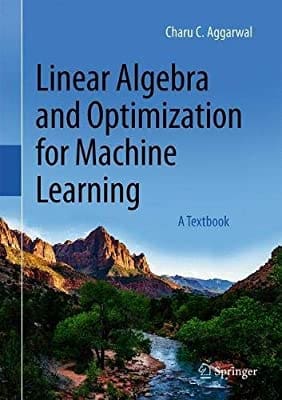Linear algebra and optimization and machine learning: A textbook
This book teaches linear algebra and optimization as the primary topics of interest, and solutions to machine learning problems as applications of these methods. Therefore, the book also provides significant exposure to machine learning.
Linear Algebra and Optimization for Machine Learning: A Textbook (Springer), authored by Charu C. Aggarwal, May 2020.
PDF Download Link (Free for computers connected to subscribing institutions only). The PDF version has links for e-readers, and is preferable in terms of equation formatting to the Kindle version.
Buy hardcover from Springer or Amazon (for general public)
Buy low-cost paperback edition (MyCopy link on right appears only for computers connected to subscribing institutions)
A frequent challenge faced by beginners in machine learning is the extensive background requirement in linear algebra and optimization. This makes the learning curve very steep. This book, therefore, reverses the focus by teaching linear algebra and optimization as the primary topics of interest, and solutions to machine learning problems as applications of these methods. Therefore, the book also provides significant exposure to machine learning. The chapters of this book belong to two categories:
Linear algebra and its applications: These chapters focus on the basics of linear algebra together with their common applications to singular value decomposition, similarity matrices (kernel methods), and graph analysis. Numerous machine learning applications have been used as examples, such as spectral clustering, kernel-based classification, and outlier detection.
Optimization and its applications: Basic methods in optimization such as gradient descent, Newton's method, and coordinate descent are discussed. Constrained optimization methods are introduced as well. Machine learning applications such as linear regression, SVMs, logistic regression, matrix factorization, recommender systems, and K-means clustering are discussed in detail. A general view of optimization in computational graphs is discussed together with its applications to backpropagation in neural networks.
Exercises are included both within the text of the chapters and at the end of the chapters. The book is written for a diverse audience, including graduate students, researchers, and practitioners. The book is available in both hardcopy (hardcover) and electronic versions. In case an electronic version is desired, it is strongly recommended to buy the PDF version (as opposed to the Kindle version for which it is hard for Springer to control layout and formatting of equations) at the following Springerlink pointer. For subscribing institutions click from a computer directly connected to your institution network to download the book for free. Springer uses the domain name of your computer to regulate access. To be eligible, your institution must subscribe to "e-book package english (Computer Science)" or "e-book package english (full collection)". If your institution is eligible, you will see a (free) `Download Book' button.

